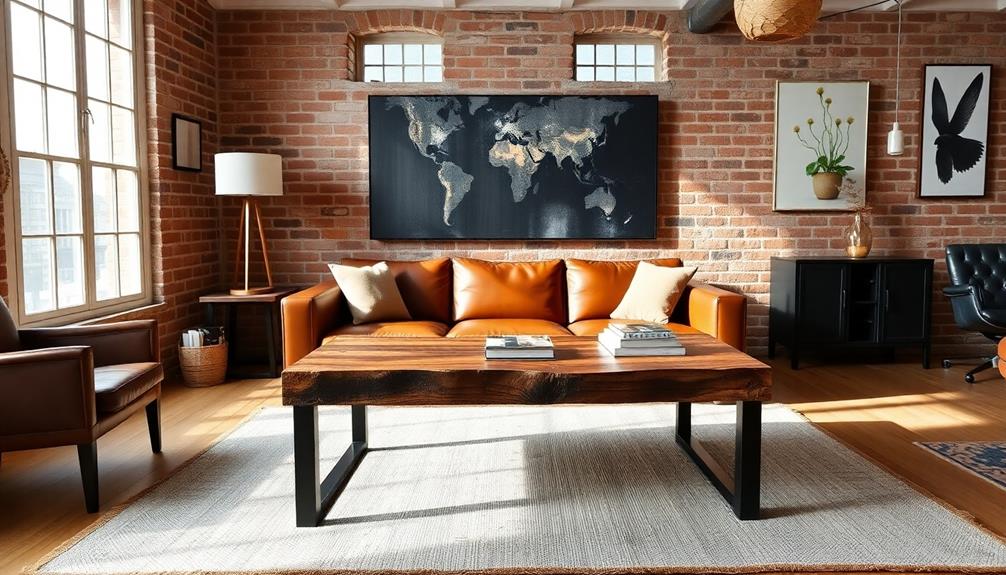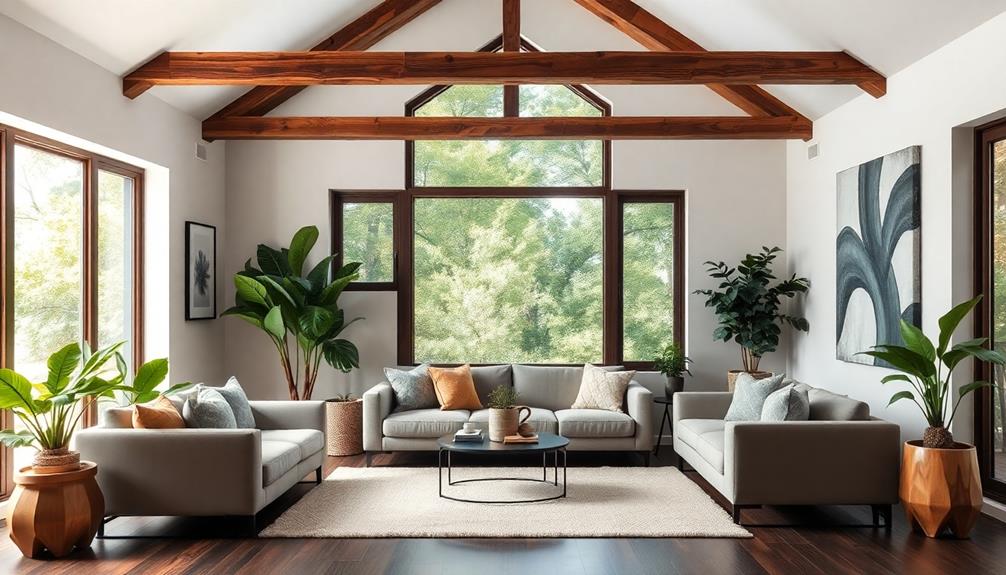To blend rustic charm with modern flair, start by choosing a warm color palette that unifies both styles, like earthy tones paired with sleek neutrals. Incorporate natural elements, such as reclaimed wood furniture and indoor plants, to add vibrancy and warmth. Mix textures by pairing rough-hewn surfaces with smooth finishes. Combine antique decor with modern art pieces for character. Don't forget to add smart technology for convenience while ensuring the devices complement rustic elements. This balance creates an inviting atmosphere that speaks to your taste. Keep exploring for even more inspiring ideas to elevate your space!
Key Takeaways
- Choose a warm color palette that combines earth tones with sleek neutrals to create a unified aesthetic.
- Mix materials like reclaimed wood and modern metal fixtures to highlight contrasts between rustic and contemporary styles.
- Incorporate natural elements such as plants and reclaimed wood to enhance both vibrancy and history in your decor.
- Blend antique furniture with modern art pieces to add character while maintaining a cohesive design theme.
- Integrate smart technology subtly to enhance functionality without detracting from the rustic charm of the space.
Achieving a Cohesive Aesthetic

To achieve a cohesive aesthetic that blends rustic charm with modern flair, you need to focus on harmony between the two styles.
Start by carefully selecting a color palette that unites both aesthetics—think warm earth tones paired with sleek neutrals. Incorporate DIY Fire Pit Ideas to enhance outdoor spaces, which can seamlessly integrate into your overall design.
Use textures to create a sense of balance; combine smooth finishes with rough-hewn surfaces to enhance visual interest.
Choose furniture and decor that reflect both styles; for instance, a modern metal light fixture can complement wooden beams beautifully.
Remember, consistency is key, so keep your design elements cohesive throughout the space.
Incorporating Natural Elements

Often, incorporating natural elements into your decor can elevate the rustic charm while adding a modern flair.
You can effortlessly create a warm and inviting atmosphere by integrating these key elements:
- Reclaimed Wood: Use reclaimed wood for furniture and decor pieces. Its unique character adds depth and history to your space.
- Greenery: Introduce plants and flowers to bring life and vibrancy. They not only purify the air but also enhance your overall aesthetic.
- Natural Textiles: Embrace materials like linen and jute for soft furnishings. These textiles add warmth and a tactile contrast to your decor.
Blending Textures and Materials

Building on the natural elements you've incorporated, blending textures and materials can further enhance the rustic charm while introducing modern sophistication.
For instance, the use of modern technology with rustic aesthetics can elevate your design approach. Combine rough-hewn wood furniture with sleek metal accents to create a tactile contrast that captivates.
Use reclaimed barn wood alongside concrete and glass to add depth and interest to your space. Pair bold earthy tones, like terracotta or olive, with modern furnishings to achieve striking contrasts that invite conversation.
Balance cool grays with warm wood tones for a cohesive aesthetic that feels intentional. Don't shy away from experimenting with vibrant colors against neutral backdrops, as this can infuse energy and life into your decor.
This thoughtful approach to texture and material will elevate your home's overall appeal.
Merging Decor Styles

Incorporating diverse decor styles can transform your space into a unique reflection of your personal taste. Merging rustic charm with modern flair allows you to create a visually engaging environment.
Start by blending antique furniture with contemporary art pieces, giving your space character while maintaining a modern edge. Consider these tips to achieve a harmonious look:
- Mix Materials: Pair reclaimed wood with sleek metal accents to create interesting contrasts. This balance can also be inspired by the innovative coffee gear that elevate the brewing experience and add a modern touch to your kitchen.
- Choose a Color Palette: Use earthy tones alongside bold colors to unify the rustic and modern aesthetics.
- Add Personal Touches: Incorporate items that reflect your journey, like travel souvenirs or family heirlooms, to enhance the eclectic vibe.
With these elements, you'll craft a space that truly feels like home.
The Role of Technology

As you blend rustic charm with modern flair, technology plays an essential role in enhancing your living space's functionality and aesthetic appeal. Smart home devices allow you to control lighting, temperature, and sound with voice commands, making life more convenient.
Recent advances in AI have even led to innovative solutions in home automation, allowing for custom adjustments based on your preferences, which can revolutionize home environments.
Integrating tech into your decor doesn't mean sacrificing style; sleek designs can complement your rustic elements seamlessly. For instance, consider furniture with built-in charging stations or multifunctional pieces that save space while looking chic.
Additionally, embracing smart lighting can create the perfect ambiance for any occasion. By finding the right balance between traditional charm and innovative technology, you can create a unique environment that reflects your personal taste and enhances your everyday living experience.
Frequently Asked Questions
How Can I Choose the Right Color Palette for My Space?
To choose the right color palette for your space, consider the emotions you want to evoke. Experiment with earthy tones, balance cool and warm shades, and draw inspiration from nature for a harmonious look.
What Are Some Budget-Friendly Ways to Achieve a Rustic-Modern Blend?
You can achieve a rustic-modern blend on a budget by using thrifted furniture, painting with earthy tones, incorporating plants, and mixing textures like wood and metal. Get creative with DIY projects to personalize your space! Look for unique thrift store finds that can be upcycled or repurposed to add character to your home. Adding statement lighting, like vintage-inspired lanterns or sleek metal fixtures, can tie together the rustic and modern decor ideas seamlessly. Don’t forget small details like woven baskets or soft throw blankets, which can enhance the cozy-meets-contemporary vibe.
How Do I Balance Large Furniture Pieces in a Small Room?
Did you know that oversized furniture can make a small room feel 20% smaller? To balance large pieces, opt for lighter colors, use multifunctional items, and arrange them strategically to create more open space and flow.
What Lighting Options Enhance Both Rustic and Modern Decor?
You can enhance both rustic and modern decor by using warm pendant lights, vintage-inspired fixtures, or sleek LED options. Mix textures, like wood and metal, to create a harmonious atmosphere that complements your space beautifully.
How Can I Personalize My Space While Maintaining a Cohesive Look?
To sprinkle your personality throughout your space, choose decor that tells your story. Mix cherished mementos with stylish elements, ensuring colors and textures harmonize. It'll create a delightful atmosphere that feels uniquely yours yet cohesive.
Conclusion
By embracing the fusion of rustic charm and modern flair, you'll create a space that's both inviting and stylish. Imagine transforming a dated farmhouse with sleek, minimalist furniture, complemented by reclaimed wood accents. Picture a cozy living room where a plush, contemporary sofa sits against a rustic barn wood wall, adorned with greenery. This balance not only reflects your personality but also tells a story of tradition meeting innovation, making your home a true sanctuary.









